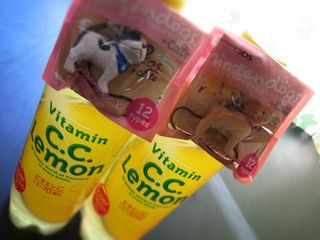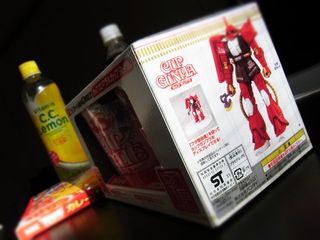
Plus Alpha is a weekly column that explores life in Japan from the perspective of American expatriate and game-industry veteran Jarik Sikat. Having worked in numerous areas of the game industry since 1994, Sikat relocated to Japan in 2010.
Most of you know Japan as the land of videogames and anime, but it’s also a snack-food paradise. Supermarkets (“suupaa”) and convenience stores (“conbini”) are stocked to the brim with a magical rainbow of canned and bottled drinks, and a variety of snacks that change with each season. And because cereal isn’t a staple breakfast food the way it is in the US, popular characters seem to find their way onto everything else. So let’s take a look at what happens when Japanese pop culture mixes it up with Japanese snack culture.

One of the most common places you’ll see anime and videogame tie-ins is on plastic drink bottles, more commonly referred to as “PET bottles.” When I first heard this phrase, I thought PET referred to cats and dogs, but it’s an abbreviation for the type of plastic used to make the container, polyethylene terephthalate. However, that fact seems to have been lost on Nintendo; this past holiday season, the Big N and C.C. Lemon (a lightly carbonated lemonade that’s not too sweet, easy to chug and claims to have 70 lemons’ worth of Vitamin C in every bottle) teamed up to give customers a free mobile-phone charm (“keitai sutorappu”) featuring one of 12 pets from Nintendogs+cats for the 3DS.
These charms tend to be a popular promotional item, especially during Christmastime. Pepsi recently had its own collaboration, offering up One Piece charms with each bottle. Capcom and beverage company Asahi also joined forces recently to promote the release of Monster Hunter Tri-3G, creating a “Tri-G Blend” of Asahi’s Dodecamin energy drink, whose taste closely resembles Red Bull. Finish the bottle and peer through a hole in the label, and you’ll see one of Monster Hunter’s friendly cat-creatures.
Buying canned coffee in Japan can be an intimidating proposition. Because of all the different blends and varieties, it can be hard to tell if what you’re getting is straight black or mixed with cream and sugar. I love Pokka-brand canned coffee; it has just the right blend and sweetness. It’s also great cold as well as hot, when hot canned and bottled drinks are offered during the winter months. I found the Pokka Dragonball coffee pictured below at Don Quijote.

The texture of “mushikeki,” or Japanese steamed cakes, reminds me of moist sponge cakes, or the soft dough used in Chinese and Filipino steamed buns. A series of mini “mushikeki” featuring characters from the Pokemon Best Wishes! anime comes in flavors like chocolate and strawberry (“ichigo”). Each cake also comes with a sticker. I picked up the strawberry flavor, and (surprisingly) loved it. If you have a strong sweet tooth and can tolerate a pretty heavy strawberry taste, this one’s for you – and it goes great with hot Pokka coffee.
Curry is as much a part of Japanese cuisine as sushi and tempura. Japanese-style curry has a thick consistency, and like American beef stew is typically mixed with potatoes and carrots. Japanese curry is typically served with a side of rice and even better with deep-fried pork (“katsu curry”). To me, curry is a hearty comfort food, so I wasn’t looking forward to the boil-in-a-bag Pokemon Best Wishes! Sweet Curry with pork and corn. From the box, I got the vibe that it was the SpaghettiOs of the Japanese curry world. Although it was a bit too soupy, the curry tasted much better than I had expected. The flavor was a little light, but being a kid-targeted item, that wasn’t too surprising.

If you’ve been to college, you know Cup Noodles. I survived for four years on instant ramen and peanut-butter sandwiches. This past summer, Nissin Foods celebrated the 40th Anniversary of its perennial brand with a series of limited edition boxed sets pairing a cup of instant ramen and a nine-cm-tall Gundam plastic model (“ganpura”). Each “ganpura” came specially designed with Cup Noodle insignias and its own cup-style container. At Akihabara model shops, the Gundam Cup Noodle boxed sets were fetching a premium, with prices topping off at 2,000 yen (around US$30). I managed to pick one up at my neighborhood Family Mart (more commonly known as “famima”) for a paltry 445 yen.

Above: Incidentally, this past summer in Yokohama, Nissin opened an entire museum devoted to its Cup Noodles
There are always new snacks and cross promotions being launched. I couldn’t fit all of the recent items in this week’s Plus Alpha, so I hope to bring you another delicious rundown soon.
Jarik Sikat has worked in the videogame industry in areas ranging from localization and product development to public relations and marketing. As a freelance journalist and writer, his work has appeared in PlayStation: The Official Magazine, Official Xbox Magazine and Newtype USA.

